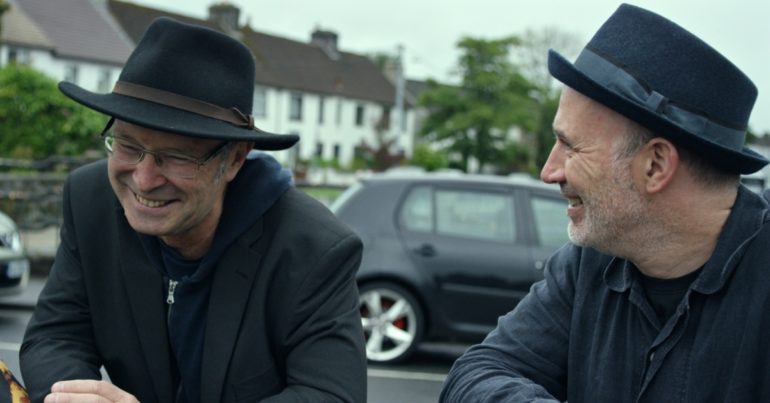It can be a while into Connemara before it clicks for the newcomer, that uncanny effect of the lack of trees. There is the sense in this desolate stone landscape—an area, as Tim Robinson put it, that “looks like the birthplace of rock itself”—that nothing really manages to take root here. We have now in Cumar a most persuasive rebuke to such sentiments: this lilting, lyrical, lovely new documentary is an advocation in form as much as in content of Galway’s capacity to foster and to nourish, told through the words and works of a small smattering of the creative community that has grown to define it. As an ode to the artistic essence of its location it is an essential example all in itself; other places have had their city symphonies, here at last is Galway’s own cinematic sean-nós.
Affection abounds from the outset in director Aodh Ó Coileáin’s stunning aerial photography, rich in the brooding palette of dark blues and greens that characterises the battered Atlantic coast. His camera captures the elements in all their brutality and beauty, stoutly setting the scene for lifelong inhabitants and the uninitiated alike. The cascading waves breaking on shore. The birds adrift the pervasive wind. The rain. The rain, The rain. And as those opening overhead shots arrive upon the harbour, you feel almost inclined to crane your neck to see over the horizon at this city sat on the edge of the world. It’s a fitting feel for a film about this place, to be drenched as much in romance as reality.
Cumar means Confluence, inasmuch as it can be taken to mean any one thing at all; it’s an effective visual conceit of the film to float bilingual definitions of the title(s) whose great varieties imply the multitudinous meanings of the city itself, perhaps one for every person in it. We get six of them from Ó Coileáin—his loose, interweaving structure is the kind that requires rigorous formal control to feel quite so effortless—via his erudite interlocutors, who by their interviews and their art equally speak to the ineffable inspiration that abounds in these streets. There is the singer Róisín Seoighe and the writer Mike McCormack, the street theatre director Noeline Kavanagh and the musician Máirtín O’Connor, the poet Rita Ann Higgins and the visual artist Padraic Reaney. In their similarities and differences they amount to an elusive, effusive image of a location as steeped in its artistic lives as they, invariably, are in it.
“If you were to ask a centipede which leg he walks with first…” O’Connor coyly starts in explaining his art; Cumar has little concern with unpacking inspiration itself, more interest in exploring how one place can congeal to seem a source of so much. But it’s to Ó Coileáin’s credit that it never seems at all hagiographic of Galway, and the film’s canny self-positioning as an effort to uncover allows it to flow freely from rapture to reproval of the city as, as one subject puts it, “a place that presents as calm the tensions that might be under it”. That’s clearly felt in the unacknowledged elephant of Galway 2020, the city’s imminent stint as European Capital of Culture in the context of which Cumar will reach cinemas, and in the light of whose public PR problems the implicit critiques of artists’ lack of central support and space must surely be seen.
It’s a tough line to toe, celebrating the intrinsic artiness of a place and asking if it’s not undervaluing that essense, but Cumar’s critiques come across, like much of this rhythmic and rhapsodic piece, as an earnest exploration out to get at broader truths. “If you’re grounded in your own place you can be critical of it” Kavanagh sagely says, and few films have ever seemed so grounded in Galway. In its near-mythic air of mystique about the particular cultural heritage of this place, where its questions of whether the city creates its artists or they create it are as insular and inextricable as a Celtic knot, there is one thing plain to see: there is magic to be had when each cherishes the other. Cumar in itself is ample evidence of that.

